A lasting and fitting tribute to honor those who gave of themselves in service to the liberation of France and Europe in World War II

South Carolina Chapter members Chris Carawan (90, left) and Gerald White (turning 90 in May, right) help Joe Watson celebrate his 93rd birthday at The Nut House, Joe’s pecan store in Ridge Spring, South Carolina on 9 April. Joe served as a mortar platoon officer in the 75th Infantry Division during the Battle of the Bulge. He was recognized for participation in the Ardennes, Rhineland, and Central Europe Campaigns. Joe began his pecan business after returning home from World War II and now grows and sells pecans, pastries, and related items from The Nut House, a renovated service station in the heart of Ridge Spring.
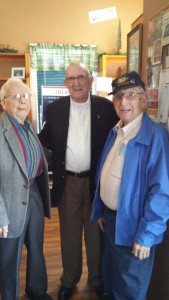
Submitted by Nelson McLeod, President

The West Palm Beach VA Medical Center has created a program to create “welcome kits” for returning US Troops. The kits contain toiletry articles and the program is funded by donations. Pictured is George Fisher, President of the Veterans of the Battle of the Bulge Southeast Florida Chapter, presenting a donation on behalf of the chapter to Charlene Szabo, director of the Medical Center.


Founded in 2003 by Catherine Roberts, mother of an Army soldier deployed to Iraq who wanted her son and others welcomed home with love and gratitude, Quilts of Valor has spread nationwide. As of the first of 2016, nearly 200,000 Quilts of Valor have been presented to veterans. From her sewing room in Seaford, Delaware, Catherine’s idea of linking quilt top makers with machine quilters has achieved her goal of awarding healing quilts to returning service men and women touched by war.
On February 3, 2016, quilts were presented to about twenty-five veterans in North Carolina by the local Group in Cabarrus County. Group is the designated term for local area quilters who make the quilts and arrange the presentation programs. Quilts are all made by local volunteer groups and are sewn with materials provided at no cost by the QOV Foundation now headquartered in Lilburn, Georgia.
The Veterans honored included myself and only one other WW II veteran, who was a 97-year-old former WAC whose service assignment was de-coding of messages! Other veterans there served from Korea to Afghanistan. The Certificate presented with the Quilt reads:
On behalf of the Quilts of Valor Foundation, In recognition of your service and sacrifice for
This nation it is a privilege to serve Honor and comfort upon you through The award of a Quilt of Valor Though we may never know the depth of your sacrifice to Protect and defend The United States of America, as a gesture Of gratitude from a grateful nation We award this Quilt to Valor to Thomas L. Burgess
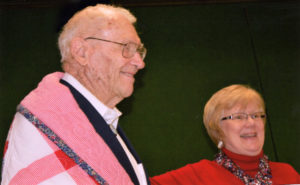
Each Quilt of Honor is an individual work of art and no two are alike. Before the presentation program began, each veteran was asked to pick the quilt we wanted to receive from a large display. When presented, the quilt was wrapped around our shoulders with the expressed hope that it would give us a warm feeling of appreciation from the QOV Foundation and the volunteer who made the quilt.
Go to www.QOVF.org/group to locate and contact the nearest group to learn of plans for future presentations and provide names of WW II veterans for award consideration. Consider donating at www.QOVF.org/donate
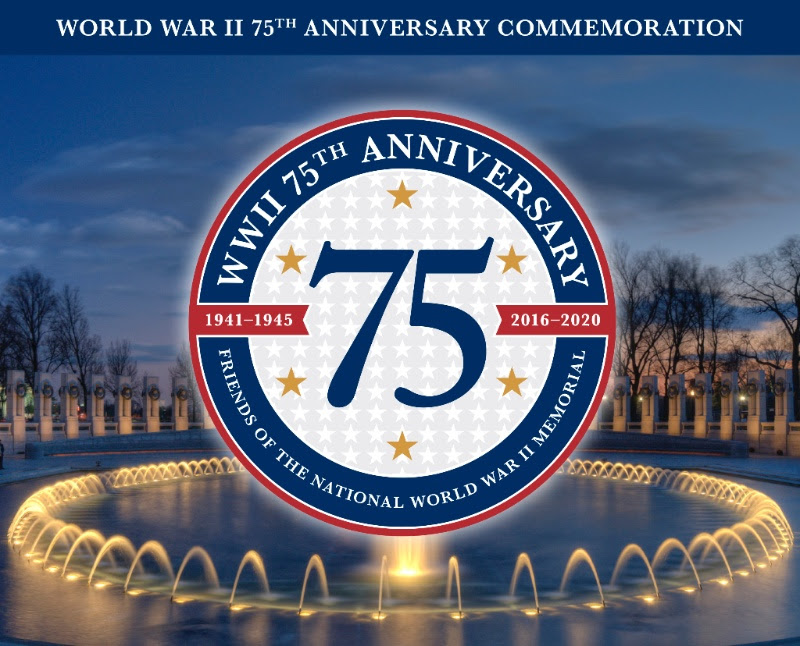
Please help the Friends of the National World War II Memorial, bring honor and recognition to our “Greatest Generation” by joining us at the WWII Memorial in Washington, DC for special ceremonies and commemoration throughout the year.
http://www.wwiimemorialfriends.org
2016 promises to be a historic year at the Memorial, as we prepare to kick-off a four-year 75th anniversary commemoration of World War II, beginning on December 7, 2016 and concluding on September 2, 2020.
Sun., May 8 V-E Day (Mother’s Day) 11:00 a.m.
Tues., May 17 U.S. Army Blues 6:00 p.m.
Mon., May 30 Memorial Day 9:00 a.m.
Mon., June 6 D-Day Commemoration Wreath Laying 10:00 a.m.
Thurs.,Aug 25 U.S. Army Blues 6:00 p.m.
Fri., Sept. 2 V-J Day 11:00 a.m.
Fri., Nov.11 Veterans Day 9:00 a.m.
Tues., Dec. 6 4th Annual Haydn Williams WWII Memorial Legacy Lecture TBD
Wed., Dec. 7 Pearl Harbor Day ~ 75th Anniversary Commemoration 1:53 p.m.
To learn more about the WWII 75th Anniversary Commemoration, click here.
Read the calendar of events for 2017-2020

 Gerald White gives students a first-hand history lesson about his experiences in World War II during the Valentines for Vets program at Richland Northeast High School in Columbia, SC. The Valentines for Vets Program provides students with an opportunity to discuss history with veterans who served in the Armed Forces in all conflicts and time periods from World War II up to the present day. Other veterans participating included South Carolina Chapter members Vernon Brantley and David Hubbard and associate members Ed Lundeen and Nelson McLeod. As David Hubbard said “The students enjoyed it, the veterans enjoyed it, and we convinced them that we had a little to do with winning World War II.”
Gerald White gives students a first-hand history lesson about his experiences in World War II during the Valentines for Vets program at Richland Northeast High School in Columbia, SC. The Valentines for Vets Program provides students with an opportunity to discuss history with veterans who served in the Armed Forces in all conflicts and time periods from World War II up to the present day. Other veterans participating included South Carolina Chapter members Vernon Brantley and David Hubbard and associate members Ed Lundeen and Nelson McLeod. As David Hubbard said “The students enjoyed it, the veterans enjoyed it, and we convinced them that we had a little to do with winning World War II.”
—Submitted by Nelson McLeod, President, South Carolina Chapter

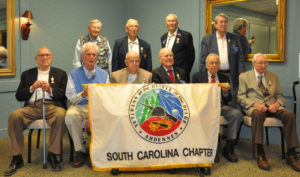 Veterans in attendance at the 19 March meeting of the South Carolina Chapter were Joe Watson, Leif Maseng, David Hubbard, Walter Hedges, Chris Carawan, Jim Hubble, Thomas Estridge, Gerald White, Tom Burgess, and Vernon Brantley. — Submitted by Nelson McLeod, President
Veterans in attendance at the 19 March meeting of the South Carolina Chapter were Joe Watson, Leif Maseng, David Hubbard, Walter Hedges, Chris Carawan, Jim Hubble, Thomas Estridge, Gerald White, Tom Burgess, and Vernon Brantley. — Submitted by Nelson McLeod, President

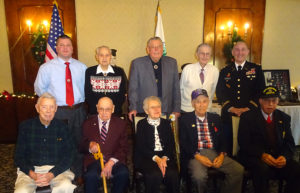 Attendees at the Hudson Valley Chapter #49 December 16, 2015 luncheon included (1st Row, L to R): John Monahan, 731st field Artillery 3rd Army; William Butz, 6 Armored Division 3rd Army; Lilian Yonelly, Women Airforce Service Pilot; Robert Gusberti, Navy-Pacific; John Schillaci, 739th Field Artillery. (2nd Row, L to R): Matthew Swedick, Chapter President (Grandfather John Swedick, KIA 12/17/44 2nd Inf Div, 23rd Inf Rgmt); Edward Graffeo, 731 Field Artillery; Alan Atwell, 28th Division MP Platoon; William Leunig, 285th Engineer Combat Battalion; Col. Richard Goldenberg, Joint Force Headquarters, NY National Guard. — Submitted by Matthew J. Swedick, Presiden, Hudson Valley Chapter #49
Attendees at the Hudson Valley Chapter #49 December 16, 2015 luncheon included (1st Row, L to R): John Monahan, 731st field Artillery 3rd Army; William Butz, 6 Armored Division 3rd Army; Lilian Yonelly, Women Airforce Service Pilot; Robert Gusberti, Navy-Pacific; John Schillaci, 739th Field Artillery. (2nd Row, L to R): Matthew Swedick, Chapter President (Grandfather John Swedick, KIA 12/17/44 2nd Inf Div, 23rd Inf Rgmt); Edward Graffeo, 731 Field Artillery; Alan Atwell, 28th Division MP Platoon; William Leunig, 285th Engineer Combat Battalion; Col. Richard Goldenberg, Joint Force Headquarters, NY National Guard. — Submitted by Matthew J. Swedick, Presiden, Hudson Valley Chapter #49

In my “normal” life, I am a filmmaker and many of you know me through the World War II documentaries that I have produced:
MARCHING ONCE MORE: Veterans return to the battlefield 60 years after the Battle of the Bulge
THANK YOU, EDDIE HART: A Dutch woman, grateful for her freedom, makes a lifelong promise to care for the grave of a soldier she never knew
NORTH CAROLINA’S WORLD WAR II EXPERIENCE: Personal accounts of North Carolinians from both the battlefield and the home front
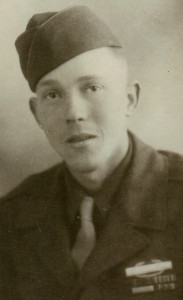
For me, sharing such stories has been a true honor as well as an opportunity to learn from those who have lived through such incredible times. During one of those productions, I met Paul Willis – Company G, 329th Regiment, 83rd Infantry Division – who fought from Normandy, through the Hurtgen and Ardennes Forests, to the Elbe River in Germany, crossing just before the war’s end.
Not long after, Paul returned to his North Carolina home where he worked at a paper and fiber company and with his wife, Evelyn, raised their two sons. He also began writing poetry – first, little jingles for colleagues – and then, more thoughtful, inspiring poems reflecting his experiences and love of history. For the past sixty years, Paul has continued to write about the war, nature, the earth, and hope for the future. A year ago, he asked me if I would help him publish a book of his work. While I had never done anything like that before, how could I say no?
And so, REFLECTIONS OF A WORLD WAR II VETERAN: POEMS ABOUT WAR AND LIFE was born and I must admit, I’m a proud parent! REFLECTIONS features sixteen poems, including two about the Battle of the Bulge. Here is one of them:
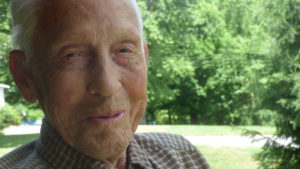
INFANTRY OF THE SNOWS
The bleak Ardennen wood shrouded
In mist and snow. Snow, a winding
Sheet for many. Yet life was there,
Merging with the shadows. In this
Solitude men moved among the trees.
The infantry of the snows. There
Amid the sounds of war borne on the
Winter wind, in the dim morning
Light they crossed the no mans land
Into the baptism of fire. When at last
The battle ended, for those who lived
The forest released its hold upon them.
For the sun in its course returned and
In pity erased the fearful record. But
To the living there remained always the
Memory of the white wasteland, and the
Infantry of the snows.
REFLECTIONS is one more way to remember the price of freedom and those who have so selflessly served. To you, I say, “Thank you!” and may your legacy live on through works such as this.
NOTE: REFLECTIONS OF A WORLD WAR II VETERAN, priced at $9.95, is available at Brenda’s website: wetbirdproductions.com. The documentary, THANK YOU, EDDIE HART, can also be purchased there.


Note: We, Jan Ross and Brad Peters, have created a comprehensive web site over the past 10 years to recognize Jan’s father’s unit that fought in the Battle of the Bulge. The web site is www.300thcombatengineersinwwii.com . The following story was published in our winter 2016 300th Quarterly newsletter and was the result of a recent inquiry to the web site.

Again we have been contacted through the web site asking for information about a member of the 300th. In January, we received a brief e-mail inquiry as follows. “My name is Roy Sweet. Roy Leslie Sweet was killed on Dec. 23, 1944. I am trying to contact anyone who might know him or what happened on the day he was killed. Any help would be great. Roy.” The name was familiar to us and our records on the web site confirmed this information about Roy Sweet. Since he was in Company B, we contacted Don Richter who was clerk for B Company and a significant contributor to the web site. Don came through as he always does and his detailed memory of 70+ years ago gave us the information requested and more.
What follows is Don’s response.
This is regarding Roy L. Sweet, Tec 4, killed in action Dec. 23, 1944 and buried in Henri-Chappelle Cemetery in Belgium. Roy Sweet was not a close friend of mine but I recall that he was a very quiet man who stayed pretty much to himself always working with the Company B radio equipment. He was Company B mail clerk in addition to being the company radio operator, the primary communication for the company. He always rode in the back seat of Company B Commander, Capt. Falvey’s jeep [Capt. Gene P. Falvey] where all of the company radio equipment was installed.
I do know that when Companies A & B were out in front of the main US Army & British Army defense line along the bank of the Meuse River, we encountered forward elements of the Germany Army advancing through the Ardennes Forest. We had roadblocks with bridges set for destruction upon the approach of the enemy. On December 23, 1944 Capt. Falvey, with his jeep driven by McGowan [Tech 5 Willie D. McGowan] and radio operator Sweet, were out checking on our various defense installations when they were approached by what appeared to be a US Army Sherman tank.
When it began firing on them, they quickly realized that it must be a tank that was captured by the Germans and was now the enemy. The jeep came to a sudden halt and McGowan and Capt. Falvey bailed out and took cover though both were wounded. Roy Sweet was mortally wounded and remained in back seat of the jeep. McGowan though wounded returned to the jeep, found Sweet dead and recovered the map case in which the defenses of Companies A & B were recorded. Capt. Falvey, though wounded, shot and killed a German soldier with his pistol. The two survivors were able to return to B Company where medics treated their wounds. McGowan was hospitalized but later returned to duty.
I know these to be true facts as some weeks later, after I became B Company clerk, I took and typed depositions from both McGowan and Falvey. Both accounts of what happened to them and Sweet on Dec 23, 1844 were almost exactly the same. McGowan received a Bronze Star for returning to the jeep and recovering the map case while under enemy fire and also being wounded he received the Purple Heart. I am sure that Falvey also received the Purple Heart.
After Roy Sweet was killed, B Company clerk Kenneth Funk became B company mail Clerk, I became B Company clerk because I was the only one who could type having learned in West High School and was given MOS Clerk Typist at Camp White. Jerry Barton was transferred from H&S Company to B Company to become radio operator. It took two men to replace Roy Sweet.
I am glad to be able to help with the inquiry about Roy Sweet. I, along with all who knew Roy, mourned his death. Cpl. Don Richter, Company B, 300th ECB”
Footnote: Warren Chancellor (300th ECB) Remembers Roy Sweet
In December of 2004, Suzy and I [Warren Chancellor and his wife], along with about 150 other veterans of the Battle of the Bulge, went on a tour of Belgium and Luxembourg to commemorate the 60th Anniversary of the Battle of the Bulge. The tour was sponsored by the governments of Belgium and Luxembourg. One of the stops on the tour was Ettelbruck, Luxembourg to visit an American WWII Museum. I was wearing a military style cap with 300th Engr., Combat Bn. embroidered on it. While walking around the museum, the curator noticed my cap and asked me if I was a member of the 300th. I replied I was. He told me that the museum had an article on display that had belonged to a member of the 300th and his name was Sweet.
My reply was, “Roy L. Sweet, a radio operator and he was killed by machine gun fire from a tank somewhere near the Belgium/Luxembourg border.” He took me to a glass-covered display of smaller articles of American equipment and there was a canteen cover imprinted Roy L. Sweet, 300th Engrs. I wanted to take a picture of it but I had left my camera on the motor coach and it was parked away from the museum. What a surprise! Here I was in Luxembourg and the curator happened to notice that I was a member of the 300th and he remembered that one particular item being there. Small world!”
In March, the younger Roy Sweet wrote: Thank you so much for the newsletter. It is wonderful to have a clear understanding of that day. I will share this with my entire family. Please keep me on the list. I would like to attend any events possible. On behalf of my uncle, my father, his father and mother. Thank you for keeping Roy alive through your organization.
Sincerely
Roy Sweet
submitted by Jan Ross, Associate Member

World War II survivor: from a warm dorm to the Battle of the Bulge
By Tony Doris, Reprinted with permission from The Palm Beach Post

George Fisher landed in Normandy 90 days after D-Day, with the 26th Infantry Division of General Patton’s 3rd Army. His unit climbed past empty Nazi pillboxes and burned-out vehicles. They camped in France for a month of training before being ordered to the front lines in the frozen, forested hills of the Ardennes region of Belgium and Luxembourg. The Battle of the Bulge began Dec. 16, 1944 and wore on until Jan. 25, 1945. A turning point in World War II, the Americans held back the German advance but at a cost of 80,000 casualties, 19,000 dead.
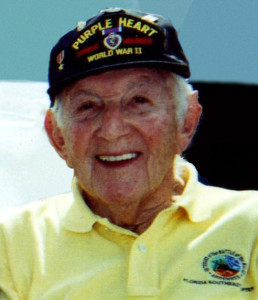
Fisher, now 91 and retired from the real estate business, lives in Palm Beach and serves as president of the Florida Southeast Chapter of Veterans of the Battle of the Bulge. The group, down from 400 members to 165, is gathering in West Palm Beach this weekend to commemorate the 71st anniversary of the battle that’s with them every day.
The reason I’m in Florida: I don’t want to see snow in my life anymore. It snowed for 10 or 12 consecutive days. It was so cold you couldn’t dig a foxhole. We couldn’t light a fire because the smoke would give us away. So there was no way to warm up. We urinated on the rifles in a circle to keep the bolts from freezing. Otherwise the rifles would not work.


Very dear friends,
I join here a link for a fabulous site which will interest you…
This is created and followed, with other, by an exceptional friend, Jean-Philippe Speder, an authentic Memory keeper.
Take a look and discover Henri-Chapelle US Cemetery like you have never done.
Have a fabulous day.
Michel Lorquet, Associate

Through a newly acquired friend in Luxembourg, I learned of a fascinating story of his 79 year old mother’s contact with some Third Army troops during the time of the Battle of the Bulge. Marguerite Groff was only 8 years old at the time.
As such, we are trying to locate four Third Army veterans who befriended the Groff family in Luxembourg in either December of 1944-January of 1945 in the small town of Strassen. I am attaching Marguerite “Maggie” Groff’s story, “A letter from Luxembourg .” I hope it will receive wide readership and that someone might recognize one or more of these soldiers and help us learn of the circumstances that found them in Strassen at this pivotal time in history.
Alan Terry Wright
alantwright@sbcglobal.net